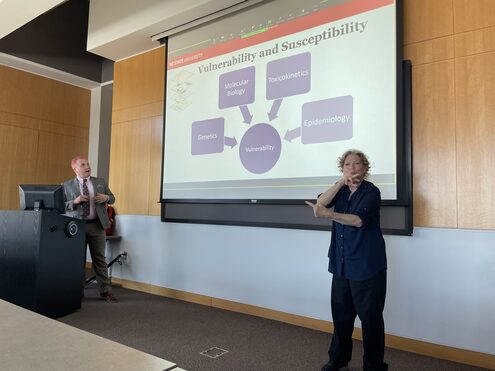The Many Layers of Toxicology: A Multi-layered Approach to Understanding Exposure and Vulnerability
The journey from chemical exposure to adverse effect is long, complex, and often poorly understood. Differences in the effects of exposure can occur at the genetic, molecular, biological, or even geographical levels. The overarching goal of this dissertation is to explore and develop a better understanding of these different levels of exposure. First, an overview of the ways in which differences within a population can change a group or individuals’ susceptibility are explored. These layers begin at the geographic level and can be as specific as effects traceable to sequences within single genes. This section talks about how changes in genes, proteins, toxicokinetic properties, and geographic location can lead to susceptibility and vulnerability differences. The dissertation then focuses on the toxicokinetics of poorly understood compounds known as per- and poly-fluoroalkyl substances (PFAS), focusing on a specific group of PFAS known as the fluoroethers. The half-lives of three fluoroethers were estimated using a linear model. These half-lives as well as the half-lives of better-studied PFAS were then used to build a model to try and predict PFAS half-lives from simple properties. The properties of PFAS were able to predict 73% of the variance of the half-lives of the PFAS. At the geographic level, one important facet of exposure is the exposure sources that are present in the environment. We used source apportionment methods on human blood samples to identify sources of PFAS exposure in two highly exposed communities in North Carolina and Colorado that were exposed via their drinking water. These methods were effective in identifying sources in these samples. They were able to separate out one known sample in each cohort that had previously been identified and multiple unknown sources with unique signatures that could be tied to other plausible sources but needed further investigation. The most personal level of vulnerability is the way that differences in biology causes differences in susceptibility. Something that can lead to these differences is the way that genes and environmental exposures can interact, or gene-environment interactions (GxE). We explored the mechanisms that lead to GxE by reviewing evidence for endocrine disrupting chemicals (EDCs) as compounds that may lead to susceptibility differences. The mechanisms of effect of EDCs and the systems they interact with are ubiquitous in the body and are driven by interactions between genes and the environment. This points to the strong possibility that differences in the genes involved in theses interactions could cause changes in susceptibility to EDC exposure. The dissertation concludes with experimental work that traces a population-level signal of GxE down to a plausible molecular genetic explanation. We suggest a mechanism that leads to susceptibility differences in exposure to a specific compound, abamectin, in a genetically diverse zebrafish population. Using a combined wet-lab and computational approach, we found a hypervariable region upstream of an important developmental gene, sox7, that leads to transcription factor binding differences affecting gene expression that is associated with differential susceptibility to exposure. The pathway from exposure to effect can differ across individuals in ways that lead to changes in vulnerability across subgroups or individuals in a population. This dissertation addresses the reality that many layers of toxicology are necessary to develop a deeper understanding of vulnerability and susceptibility.


